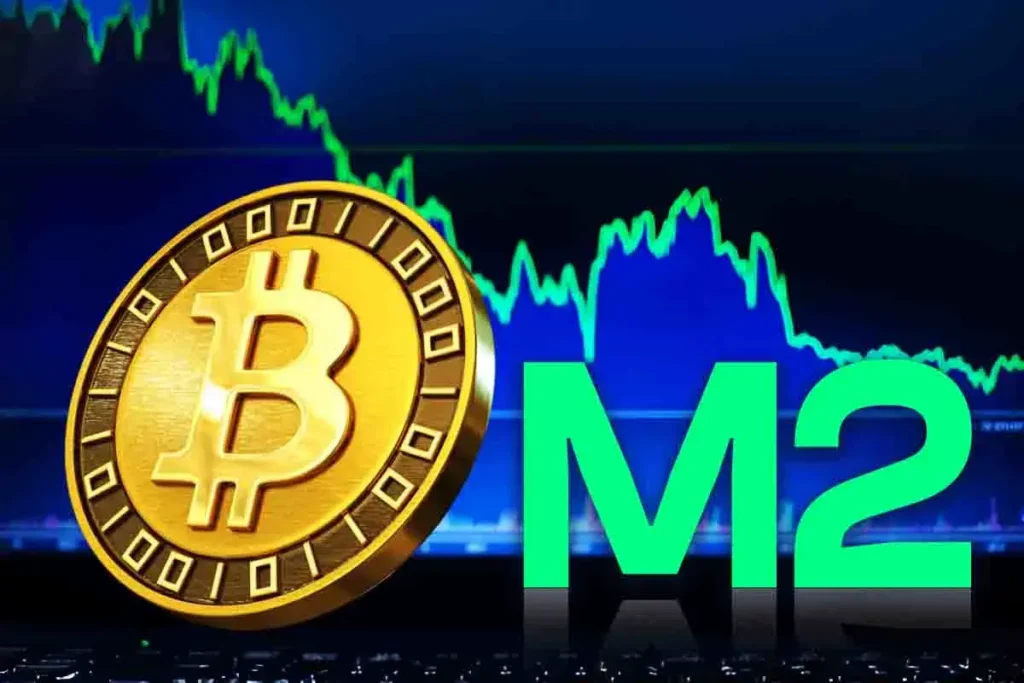The Bitcoin Correction: Analyzing Correlations with M2 Money Supply
In recent days, Bitcoin (BTC) experienced a significant correction, sparking discussions among analysts about its relationship with the M2 Money supply. Influential figures like Raoul Pal and Abra CEO Bill Barhydt are utilizing Bitcoin’s correlation with M2 to make predictions about its future price trajectory. This exploration of Bitcoin against M2 serves a dual purpose: it not only reflects Bitcoin’s growing significance in the digital asset landscape but also provides insights into the broader economic conditions impacting cryptocurrency valuation.
Bitcoin’s Predicted Ascension Amid Economic Shifts
Abra’s CEO, Bill Barhydt, recently articulated his take on the Bitcoin versus M2 money supply trend through his social media platform. Barhydt posits that as the global money supply increases, assets perceived as "risk-on," such as Bitcoin, stand to gain significantly. His analysis suggests that fiat currencies become devalued as more money circulates, consequently enhancing the value of alternative assets like Bitcoin. Following a brief bearish outlook where Bitcoin’s price dipped to $103,000, Barhydt strongly believes that Bitcoin could rebound, potentially reaching an impressive $130,000 by August or September. This optimistic forecast hinges on various factors, including institutional purchases that contribute to Bitcoin’s scarcity in the market.
Historical Patterns and the M2 Correlation
Despite the recent price correction, Bitcoin maintains its alignment with historical trends. Traditionally, May has been a bullish month for Bitcoin, with an average growth rate of 19%. Current data indicates that despite recent volatility, Bitcoin has recorded a modest increase of 10% this month. As of now, BTC is priced at approximately $104,402.78, a marginal uptick given recent fluctuations. Notably, Bitcoin reached an all-time high (ATH) of $111,970 on May 22, marking a pivotal moment in its price history. Analysts remain optimistic, suggesting that, akin to past correlations, Bitcoin could rebound from its recent selloff, especially as the M2 Money supply continues to reach unprecedented heights.
The Global Acceptance of Bitcoin
The growing acceptance of Bitcoin extends beyond its value as an asset. Several U.S. states have passed legislation to recognize Bitcoin as a strategic reserve asset, indicating a broader recognition of its potential. Senator Cynthia Lummis has stated that Congress will prioritize the Bitcoin reserve bill, signaling governmental intentions to bolster its attractiveness. However, not every corporation is embracing Bitcoin. Firms like Meta and Microsoft have opted against Bitcoin as a reserve asset, but others, like GameStop, are moving to include Bitcoin in their financial strategies. This mixed sentiment highlights the evolving landscape of institutional acceptance and the diverse viewpoints on Bitcoin’s status as a vital reserve asset.
The Outlook for Bitcoin Amid Institutional Adoption
From an investment perspective, the ongoing institutional adoption of Bitcoin adds a layer of complexity to its future price trends. The purchase of 4,020 BTC by a significant investor illustrates this trend, as institutional players recognize Bitcoin’s potential as a hedge against economic uncertainties. Although skepticism persists regarding the robustness of Bitcoin’s correlation with M2 Money supply, many analysts assert that historical data indicates a persistent pattern over extended timeframes. As long as institutional interest remains high, Bitcoin is likely to benefit from global monetary policy shifts.
The Dynamics of M2 Growth and Bitcoin’s Price Movement
With the global M2 Money supply reaching all-time highs, analysts point out that Bitcoin’s price dynamics could follow suit—with a lag. Markets appear to be responding to the dovish policies being adopted in economies like the U.S. and China due to recession anxieties. The ongoing rise in M2 may serve as a precursor for Bitcoin’s ascent in value, signaling a potential upward trajectory in the coming weeks. Given the current economic climate, long-term investors seem undeterred by the recent corrections, emphasizing Bitcoin’s position as "the mother of all liquidity."
Conclusion: Navigating the Future of Bitcoin
As Bitcoin continues to evolve within the financial landscape, its correlation with the M2 Money supply remains a case study in asset valuation. The discussions surrounding its price corrections and potential rebounds reflect broader economic trends and investor sentiment. While analysts like Bill Barhydt express optimism over Bitcoin reaching new heights, it’s crucial for investors to approach this market with caution, informed by ongoing analyses and trends. Ultimately, the future of Bitcoin will hinge on its adaptability and acceptance in a rapidly changing economic environment. As more institutions recognize its value and legislative frameworks evolve, Bitcoin’s journey is poised to remain a focal point within the cryptocurrency realm.
















